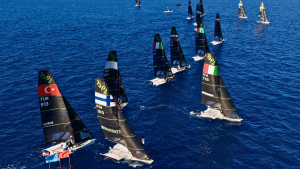Theater Style Racing – 49ers to Test
Hi 49er sailors,
See the outline below and be prepared to discuss this concept with
your executive at the AGM at the European Championships in Poland.
Please complete this survey once you have read the article: THEATRE STYLE RACING SURVEY.
The Big Picture:
One way to increase the media and spectator appeal for sailing it to
frame our sport in an accessible venue. As the regatta moves to the
final stages, we have seen the top 10 move to a finals format. By
advancing that formula, we can enhance the benefits to the media and
spectators. See the diagram below, using lane rope to restrict the
width of the course it will increase the ability of the media and
spectators to see what is going on while at the same time increase the
number of tactical situations sailors must navigate.
The concept is to have small fleets race in short courses (9-12 mins)
with a width boundary (swim lanes-actual swim lane, like in a pool) to
force the fleet into many tactical situations and keep them close
together. There would be lots of maneuvering, the aspect ratio will
need to be tested, visualize that 8-10 tacks are mandatory per beat!

One alternative for moving sailing forward
Picture grandstands on barges right on the edge of the racecourse
with fans able to cheer loud enough for sailors to hear them! Music, a
PA system with an announcers, it could all happen in this enclosed venue
and the sailors should be able to race unobstructed by the fans.
The style of racing would certainly be very different. Obviously the
emphasis on strategic decision making will be vastly reduced with a
greater premium on boathandling, tactical decision making, and rising to
the occasion. In a couple of cases I think this could be a good
showcase for sailing. Yes, it’s not sailing in it’s pure form but I do
believe that this would be a fair way to have a winner takes all final
race.
We think that this format would work well for some of the boat types,
but certainly not all of them. For example, 49ers would work well as
they are spectacular when they do maneuvers and the swim lanes will come
into play both up and downwind. Lasers/Radials would also work well as
they are so maneuverable and can get into some great tactical
situations but swim lanes would only come into play on the upwind.
Windsurfers would probably be terrible as they tack so anesthetically,
so this format should not be considered for them. This isn’t meant to
be a solution for all, but rather just a flourish for a couple of
classes to grab media attention and earn some money through ticket sales
and TV. The racing should also be pretty spectacular yet still very
fair to the sailors!
How to get there?
Here are two format that we have brainstormed that would allow the
final stages of racing to be completed in this sailing theatre format.
Both of these proposals result in the winner of the final race winning
the regatta.
In both of these formats the regatta begins as regattas do currently
with open fleet racing creating a low point scoring leaderboard.
Match Race Final
The regatta progresses as per normal until the top 10 are known.
Instead of a one race final, that top 10 move to a day of ‘theatre
racing’
They do 4 – 6 races no discards from these races. Media and
spectators can watch as described above. Each race could be scored
double points or what ever weighting people want to place on the
qualifying.
At the end of the racing the 3 and 4 placed teams match race for the
Bronze followed by the 1 and 2 placed team match racing for the Gold.
This way the top sailors rise to the top. There is no randomness and
the tv get two shots at exciting racing with the overall winner
crossing the line first.
“SailorCross” style
To summarize, qualifying is like normal, for example, 3 days of fleet
racing. The change comes at the gold/silver fleet split. Instead of
gold fleet, the top 24 move on to quarterfinals. (or just the top 12
move on straight to semi finals if there are smaller fleets, like in the
Olympics)
Assuming quarterfinals, 4 flights of 6 teams each race off. See the
diagram to see how it all looks.
Every team does 4 races in 2 predetermined flights on side by side
courses that have swim lanes for boundaries between the courses (see
diagram, not to scale). At the end of the day it is scored like a
normal day with a ranking from 1 to 24, low points. Finish is at the
top, boats sail around the course to get back to the start for the next
races to keep things moving. Spectators and Media are right in the
action, so long as they aren’t driving up and down the course too much
they shouldn’t interfere with the sailors at all.
Top 12 move on to semi finals… and a single course like in the top
diagram.
1 – 6 race each other and 7 – 12 race each other. Three races each,
only 1 course need be used but swim lanes act as boundary to keep racing
tight and allow spectators right close to the action. From 1 – 6, top 3
move to Finals, 4, – 6 move to repachage. From 7 – 12, top 3 move to
repachage. The repachage group races 3 races, the top 3 of that move to
final. (If racing can not occur after semi finals (wind, etc. 4, 7, 8
move to finals.
Final – 1 race, winner takes all with 6 well qualified boats.
We think that a winner takes all final will be palatable to the
sailors in this format as the ‘rewards’ for doing well in qualifying and
quarterfinals are cashed in by having a second chance to make the
finals instead of by having a points lead in the final. This should
allow an excellent day of TV coverage with semi finals, repachage and
then finals as a line up, just like they do for snowboardcross.
What do you think? Surve here: THEATRE STYLE RACING
Ben Remocker & Simon Hiscocks







